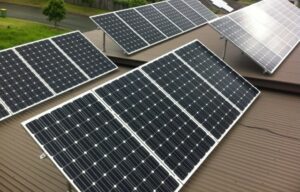Solar panels are made to be reliable.
Most, if not all, are rated and built to last for around 20 to 30 years.
However, as reliable as solar panels appear to be, some might have issues that you should be aware of.
Some companies offer what appear to be quality solar panels but cut corners throughout the production process.
Other solar panels may just have issues from improper installation, general wear-and-tear, or unavoidable defects.
Whatever the reason is, you should be aware of the telltale signs of faulty solar panels, which we will discuss below.
1. Delamination and Rust
Solar panels are specifically designed to withstand harsh weather conditions, but some things can go wrong along the way.
For example, if you notice that your panels are peeling away and there is rust in the internal components, you may have a faulty solar panel.
“If a solar panel is not weatherproofed, its efficiency may be lowered, or worse, it may cease to function altogether.”
Ensure that your panels are sealed shut with a vacuum seal every now and then.
Delamination and water seeping into your solar panels will only bring you headaches, so it is best to prevent them.
2. Damaged Glass Panels
In line with weatherproofing, glass panels serve as a solar panel’s first line of defense against rain.
However, once you see damaged glass panels on any of your panels, water may have made its way inside it.
This creates more possibilities for issues later down the road.
Additionally, damaged glass panels also refract light unevenly, creating less efficient photovoltaic systems.
Foreign debris can also get in, further limiting the amount of sunlight that your solar panels can absorb.
3. Chipped Solar Cells
Solar cells are the main components that convert sunlight into usable energy.
Unfortunately, these parts are sensitive to damage, and even the slightest touch can crack or chip them.
This is why solar panel manufacturers provide plenty of protection for solar cells.
If a solar cell does get chipped, it can still function and offer energy, albeit at a less efficient rate.
Chipped solar cells are often plagued with issues of low amperage and voltage even if they still work.
4. Hot Spots
Although solar panels need direct sunlight to work properly, too much sunlight can cause problems.
Over time, if a solar panel is placed under direct sunlight, specific portions become more resistant to electricity.
These portions are called hot spots.
Hot spots cause degraded electricity flow and may potentially lead to burnt solar cells if not addressed.
They may also be caused by poor soldering and cracks in the solar panel, leading to more electrical resistance.

5. Snail Trails
Snail trails are discoloured streaks or smudges that run across a solar panel.
They are formed over time from micro-cracks that allow air to enter.
These result in the oxidation of the internals of a solar panel, specifically, the silver paste used to carry the generated electricity.
Oxidized silver paste has a reduced conductivity compared to regular silver paste.
Over time, this can cause breakdowns because the electricity is not carried properly.
Though snail trails are usually found a few years after installation, it is still worth checking if your solar panels have the telltale brown streaks running across them to minimize damage.
6. Microcracks
Earlier in this article, we mentioned that solar cells are fragile components.
They are actually so delicate that they can be damaged even during transportation.
In addition, solar cells can develop microcracks that are unnoticeable to the naked eye even before they are installed.
Microcracks create tiny disconnections between the cells, resulting in deteriorated electrical performance.
They can also grow in size over time, forming larger cracks and causing more damage.
In addition, these cracks may also become hot spots as the solar panel gets continuously exposed to sunlight.
Frequently Asked Questions
What Happens If The Solar Panel Fails?
If you already have a damaged solar panel, there are options for replacement panels. Some solar panel manufacturers offer warranties on their products, so always watch out for that. It is also more cost-efficient to get an upgraded system rather than fix broken parts on a faulty one.
Why Would A Solar Panel Stop Working?
Solar panels will stop working if any of their key components fail. For example, the solar cells may have been damaged by exposure to the sun, foreign objects, or even poor soldering on a faulty part.
How Can You Tell The Quality Of A Solar Panel?
The quality of a solar panel is indicated by the brand and environmental certifications. It should also have a high energy conversion efficiency, low degradation rates, and other relevant information regarding its performance.
Final Thoughts
Solar panels are made to withstand a wide range of conditions. After all, they have to stay outside and convert sunlight into electricity 24/7.
However, that does not mean they are not susceptible to damage. By looking at the possible signs of faulty solar panels, you can ensure that you can take the proper precautions to limit the damage to your solar system.







